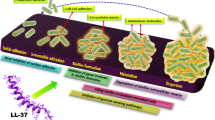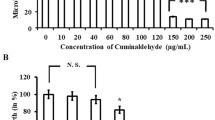Abstract
Coprisin is a 43-mer defensin-like peptide from the dung beetle, Copris tripartitus. In this study, we tested its minimum inhibitory concentration and performed combination assays to confirm the antibacterial susceptibility of coprisin and synergistic effects with antibiotics. The synergistic effects were evaluated by testing the effects of coprisin in combination with ampicillin, vancomycin, and chloramphenicol. The results showed that coprisin possessed antibacterial properties and had synergistic activities with the antibiotics. To understand the synergistic mechanism(s), we conducted hydroxyl radical assays. Coprisin alone and in combination with antibiotics generated hydroxyl radicals, which are highly reactive oxygen forms and the major property of bactericidal agents. Furthermore, the antibiofilm effect of coprisin alone and in combination with antibiotics was investigated. Biofilm formation is the source of many relentless and chronic bacterial infections. The results indicated that coprisin alone and in combination with antibiotics also had antibiofilm activity. Therefore, we conclude that coprisin has the potential to be used as a combinatorial therapeutic agent for the treatment of infectious diseases caused by bacteria.
Similar content being viewed by others

References
Archer GL (1998) Staphylococcus aureus: a well-armed pathogen. Clin Infect Dis 26:1179–1181
Batoni G, Maisetta G, Brancatisano FL, Esin S, Campa M (2011) Use of antimicrobial peptides against microbial biofilms: advantages and limits. Curr Med Chem 18:256–279
Brogden KA (2005) Antimicrobial peptides: pore formers or metabolic inhibitors in bacteria? Nat Rev Microbiol 3:238–250
Christensen GD, Simpson WA, Younger JJ, Baddour LM, Barrett FF, Melton DM, Beachey EH (1985) Adherence of coagulase-negative staphylococci to plastic tissue culture plates: a quantitative model for the adherence of staphylococci to medical devices. J Clin Microbiol 22:996–1006
Costerton JW, Irvin RT, Cheng KJ (1981) The bacterial glycocalyx in nature and disease. Ann Rev Microbiol 35:299–324
Eliopoulos GM, Moellering RC (1991) Antimicrobial combinations. In: Lorian V (ed) Antibiotics in laboratory medicine, 3rd edn. The Williams &Wilkins Co., Maryland, pp 432–492
Gomes F, Teixeira P, Cerca N, Azeredo J, Oliveira R (2011) Effect of farnesol on structure and composition of Staphylococcus epidermidis biofilm matrix. Curr Microbiol 63:354–359
Hwang JS, Lee J, Kim YJ, Bang HS, Yun EY, Kim SR, Suh HJ, Kang BR, Nam SH, Jeon JP, Kim I, Lee DG (2009) Isolation and characterization of a defensin-like peptide (coprisin) from the dung beetle, Copris tripartitus. Int J Pept 2009:1–5
Kim JS, Heo P, Yang TJ, Lee KS, Jin YS, Kim SK, Shin D, Kweon DH (2011) Bacterial persisters tolerate antibiotics by not producing hydroxyl radicals. Biochem Biophys Res Commun 413:105–110
Kohanski MA, Dwyer DJ, Hayete B, Lawrence CA, Collins JJ (2007) A common mechanism of cellular death induced by bactericidal antibiotics. Cell 130:797–810
Lee J, Hwang JS, Hwang I, Cho J, Lee E, Kim Y, Lee DG (2012) Coprisin-induced antifungal effects in Candida albicans correlate with apoptotic mechanisms. Free Radic Biol Med 52:2302–2311
Mazumdar K, Dutta NK, Kumar KA, Dastidar SG (2005) In vitro and in vivo synergism between tetracycline and the cardiovascular agent oxyfedrine HCl against common bacterial strains. Biol Pharm Bull 28:713–717
Merrifield B (1986) Solid phase synthesis. Science 232:341–347
Monroe D (2007) Looking for chinks in the armor of bacterial biofilms. PLoS Biol 5:e307
Price M, Reiners JJ, Santiago AM, Kessel D (2009) Monitoring singlet oxygen and hydroxyl radical formation with fluorescent probes during photodynamic therapy. Photochem Photobiol 85:1177–1181
Sheppard R (2003) The fluorenylmethoxycarbonyl group in solid phase synthesis. J Pept Sci 9:545–552
Wayne PA (2003) Methods for dilution antimicrobial susceptibility tests for bacteria that grow aerobically. Clinical and Laboratory Standards Institute M7-A6
Wayne PA (2005) Performance standards for antimicrobial susceptibility testing, fifteenth informational supplement. Clinical and Laboratory Standards Institute MS100-S15
Wei GX, Campagna AN, Bobek LA (2006) Effect of MUC7 peptides on the growth of bacteria and on Streptococcus mutans biofilm. J Antimicrob Chemother 57:1100–1109
Yeaman MR, Yount NY (2003) Mechanisms of antimicrobial peptide action and resistance. Pharmacol Rev 55:27–55
Acknowledgment
This study was supported by a Grant from the Next-Generation BioGreen 21 Program (No.PJ008158), the Rural Development Administration, the Republic of Korea.
Author information
Authors and Affiliations
Corresponding author
Rights and permissions
About this article
Cite this article
Hwang, Is., Hwang, JS., Hwang, J.H. et al. Synergistic Effect and Antibiofilm Activity Between the Antimicrobial Peptide Coprisin and Conventional Antibiotics Against Opportunistic Bacteria. Curr Microbiol 66, 56–60 (2013). https://doi.org/10.1007/s00284-012-0239-8
Received:
Accepted:
Published:
Issue Date:
DOI: https://doi.org/10.1007/s00284-012-0239-8



